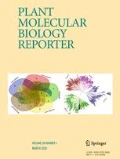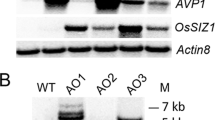Abstract
Salinity and drought are two major environmental stresses that limit the growth and productivity of cotton. To improve cotton’s drought and salt tolerance, transgenic cotton plants expressing the Arabidopsis vacuolar Na+/H+ antiporter gene AtNHX1 and H+-pyrophosphatase gene AVP1 were produced by cross-pollination of two single-gene-overexpressing plants. The salt tolerance and drought tolerance were further enhanced by simultaneously overexpressing AVP1 and AtNHX1 in comparison to AVP1 or AtNHX1 single-gene-overexpressing plants and to wild-type plants. Plant height, boll number, and fiber yield of AVP1/AtNHX1-co-overexpressing plants were higher than those of AVP1-overexpressing, AtNHX1-overexpressing, segregated non-transgenic line, and wild-type plants under saline and drought conditions. The photosynthetic rate of AVP1/AtNHX1-co-overexpressing plants was significantly higher than that of single-gene-overexpressing and wild-type plants under 200 mM NaCl treatment. In addition, the root systems of AVP1/AtNHX1-co-overexpressing plants were larger than those of single-gene-overexpressing and wild-type plants, which was likely due to increased auxin polar transport in the root systems of the AVP1/AtNHX1-co-overexpressing plants. Moreover, these AVP1/AtNHX1-co-overexpressing cotton plants produced 24 % higher fiber yield under low-irrigation conditions and 35 % higher fiber yield under dryland conditions as compared to wild-type cotton in the field.










Similar content being viewed by others
References
Agarwal PK, Shukla PS, Gupta K, Jha B (2013) Bioengineering for salinity tolerance in plants: state of the art. Mol Biotechnol 54:102–123
Apse MP, Aharon GS, Snedden WA, Blumwald E (1999) Salt tolerance conferred by overexpression of a vacuolar Na+/H+ antiport in Arabidopsis. Science 285:1256–1258
Banjara M, Zhu L, Shen G, Payton P, Zhang H (2011) Expression of an Arabidopsis sodium/proton antiporter gene (AtNHX1) in peanut to improve salt tolerance. Plant Biotechnol Rep 6:59–67. doi:10.1007/s11816-011-0200-5
Bartels D, Sunkar R (2005) Drought and salt tolerance in plants. Crit Rev Plant Sci 24:23–58
Bhaskaran S, Savithramma DL (2011) Co-expression of Pennisetum glaucum vacuolar Na+/H+ antiporter and Arabidopsis H+-pyrophosphatase enhances salt tolerance in transgenic tomato. J Exp Bot 62:5561–5570. doi:10.1093/jxb/err237
Bray EA (1997) Plant responses to water deficit. Trends Plant Sci 2:48–54
Deikman J, Petracek M, Heard JE (2012) Drought tolerance through biotechnology: improving translation from the laboratory to farmers’ fields. Curr Opin Biotechnol 23:243–250
Dong H (2012) Technology and field management for controlling soil salinity effects on cotton. AJCS 6(2):333–341
Gaxiola RA, Li J, Undurraga S, Dang LM, Allen GJ, Alper SL, Fink GR (2001) Drought-and salt-tolerant plants result from overexpression of the AVP1 H+-pump. Proc Natl Acad Sci U S A 98:11444–11449
Gaxiola RA, Fink GR, Hirschi KD (2002) Genetic manipulation of vacuolar proton pumps and transporters. Plant Physiol 129:967–973
Gaxiola RA, Palmgren MG, Schumacher K (2007) Plant proton pumps. FEBS Lett 581:2204
Gouiaa S, Khoudi H, Leidi EO, Pardo JM, Masmoudi K (2012) Expression of wheat Na+/H+ antiporter TNHXS1 and H+-pyrophosphatase TVP1 genes in tobacco from a bicistronic transcriptional unit improves salt tolerance. Plant Mol Biol 79:137–155
He C et al (2005) Expression of an Arabidopsis vacuolar sodium/proton antiporter gene in cotton improves photosynthetic performance under salt conditions and increases fiber yield in the field. Plant Cell Physiol 46:1848–1854
Kuppu S et al (2013) Water-deficit inducible expression of a cytokinin biosynthetic gene IPT improves drought tolerance in cotton. PLoS One 8:e64190
Li J et al (2005) Arabidopsis H+-PPase AVP1 regulates auxin-mediated organ development. Science 310:121–125
Li TY, Zhang Y, Liu H, Wu Y, Li W, Zhang H (2010) Stable expression of Arabidopsis vacuolar Na+/H+ antiporter gene AtNHX1, and salt tolerance in transgenic soybean for over six generations. Chin Sci Bull 55:1127–1134
Liu S, Zheng L, Xue Y, Zhang Q, Wang L, Shou H (2010) Overexpression of OsVP1 and OsNHX1 increases tolerance to drought and salinity in rice. J Plant Biol 53:444–452
Liu L et al (2012) Coexpression of ScNHX1 and ScVP in transgenic hybrids improves salt and saline-alkali tolerance in alfalfa (Medicago sativa L.). J Plant Growth Regul 32:1–8. doi:10.1007/s00344-012-9270-z
Mittler R, Blumwald E (2010) Genetic engineering for modern agriculture: challenges and perspectives. Annu Rev Plant Biol 61:443–462
Munns R, Tester M (2008) Mechanisms of salinity tolerance. Annu Rev Plant Biol 59:651–681
Park S et al (2005) Up-regulation of a H+-pyrophosphatase (H+-PPase) as a strategy to engineer drought-resistant crop plants. Proc Natl Acad Sci U S A 102:18830–18835
Pasapula V et al (2011) Expression of an Arabidopsis vacuolar H+-pyrophosphatase gene (AVP1) in cotton improves drought- and salt tolerance and increases fibre yield in the field conditions. Plant Biotechnol J 9:88–99. doi:10.1111/j.1467-7652.2010.00535.x
Qin H et al (2013) Expression of the Arabidopsis vacuolar H+-pyrophosphatase gene AVP1 in peanut to improve drought and salt tolerance. Plant Biotechnol Rep 7:345–355
Rivero RM, Kojima M, Gepstein A, Sakakibara H, Mittler R, Gepstein S, Blumwald E (2007) Delayed leaf senescence induces extreme drought tolerance in a flowering plant. Proc Natl Acad Sci U S A 104:19631–19636
Shi H, Lee BH, Wu SJ, Zhu JK (2002) Overexpression of a plasma membrane Na+/H+ antiporter gene improves salt tolerance in Arabidopsis thaliana. Nat Biotechnol 21:81–85
Wei A, He C, Li B, Li N, Zhang J (2011) The pyramid of transgenes TsVP and BetA effectively enhances the drought tolerance of maize plants. Plant Biotechnol J 9:216–229
Zhang HX, Blumwald E (2001) Transgenic salt-tolerant tomato plants accumulate salt in foliage but not in fruit. Nat Biotechnol 19:765–768
Zhang HX, Hodson JN, Williams JP, Blumwald E (2001) Engineering salt-tolerant Brassica plants: characterization of yield and seed oil quality in transgenic plants with increased vacuolar sodium accumulation. Proc Natl Acad Sci U S A 98:12832–12836
Zhao FY, Zhang XJ, Li PH, Zhao YX, Zhang H (2006) Co-expression of the Suaeda salsa SsNHX1 and Arabidopsis AVP1 confer greater salt tolerance to transgenic rice than the single SsNHX1. Mol Breed 17:341–353
Acknowledgments
This work was supported by grants from the National Natural Science Foundation of China to Guoxin Shen (31170793), the National Natural Science Foundation of Zhejiang province to Guoxin Shen (Z12C130011), and the program of Shaoxing 330 Overseas Elites to Guoxin Shen. This work was also supported by a national research initiative competitive grant (no. 2007-35100-18382) from USDA National Institute of Food and Agriculture.
Author information
Authors and Affiliations
Corresponding authors
Additional information
Guoxin Shen and Jia Wei are co-first authors.
Rights and permissions
About this article
Cite this article
Shen, G., Wei, J., Qiu, X. et al. Co-overexpression of AVP1 and AtNHX1 in Cotton Further Improves Drought and Salt Tolerance in Transgenic Cotton Plants. Plant Mol Biol Rep 33, 167–177 (2015). https://doi.org/10.1007/s11105-014-0739-8
Published:
Issue Date:
DOI: https://doi.org/10.1007/s11105-014-0739-8




